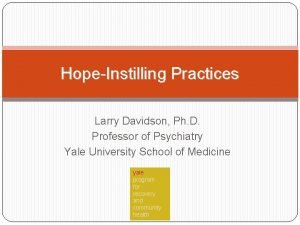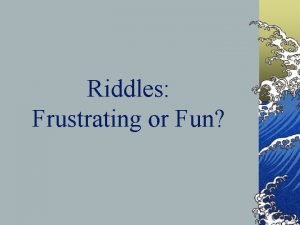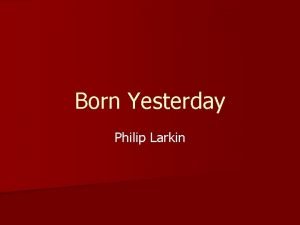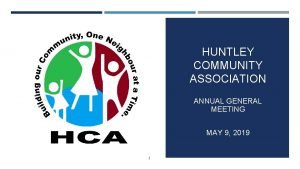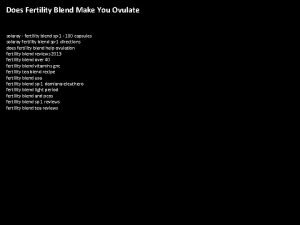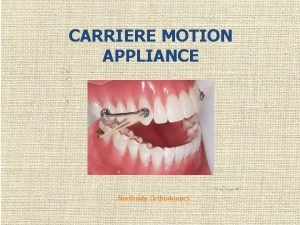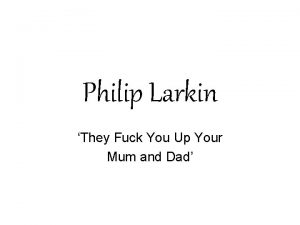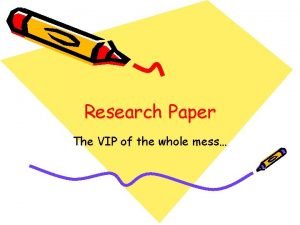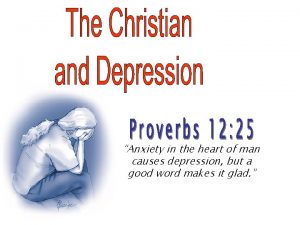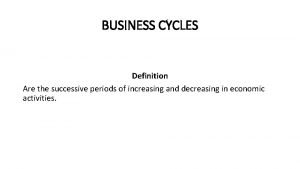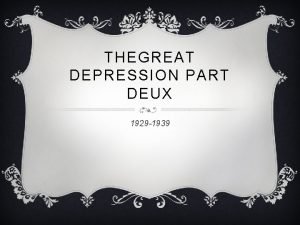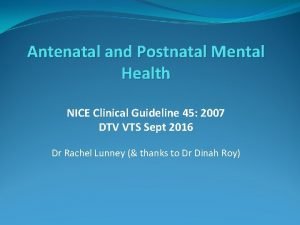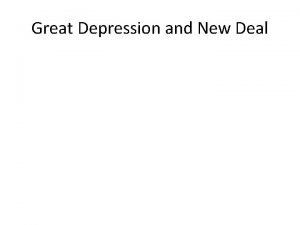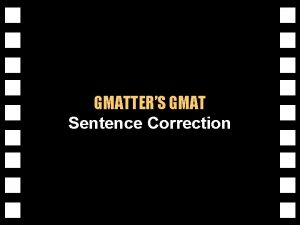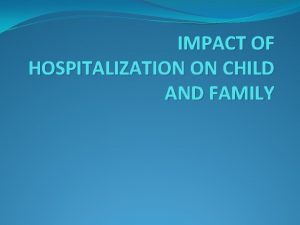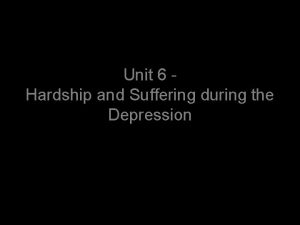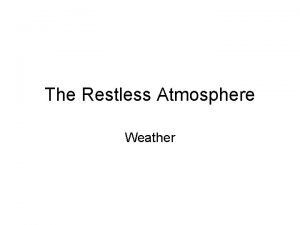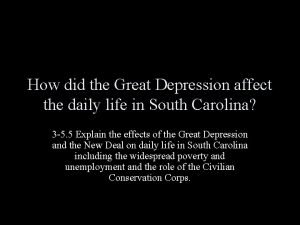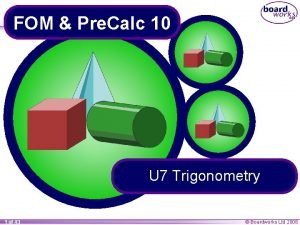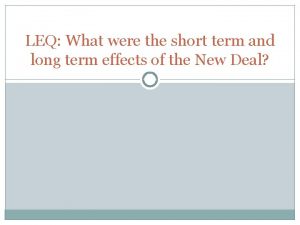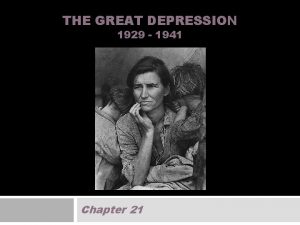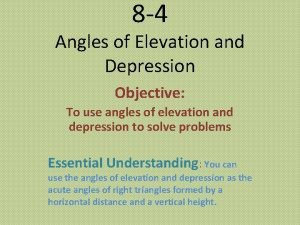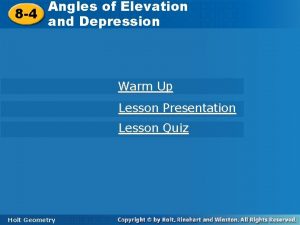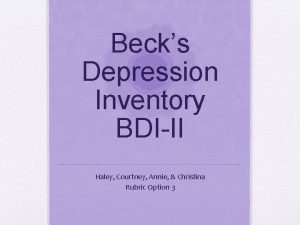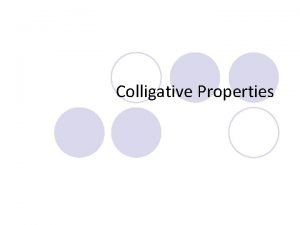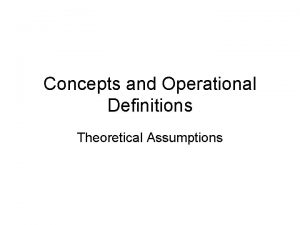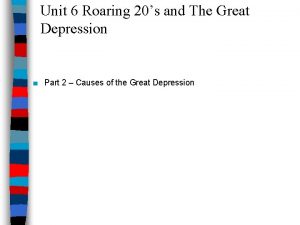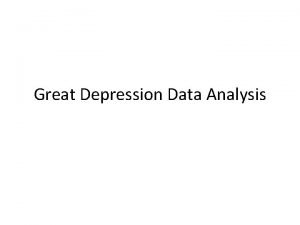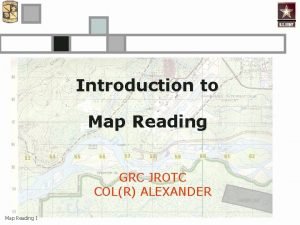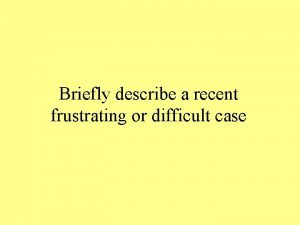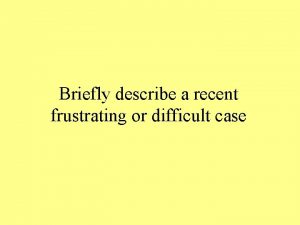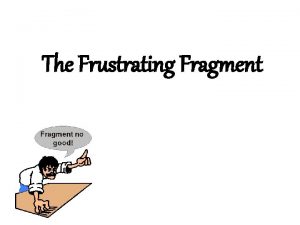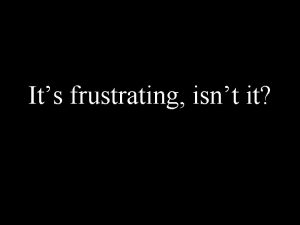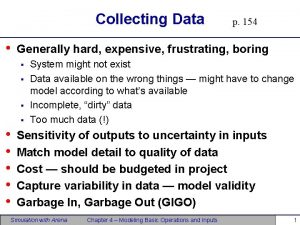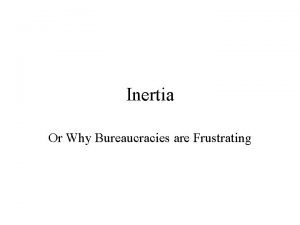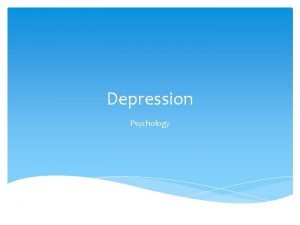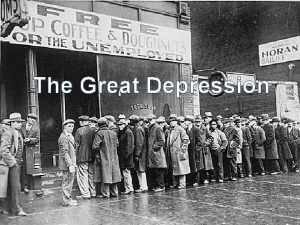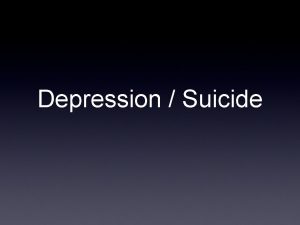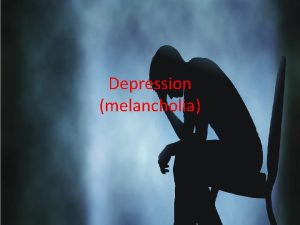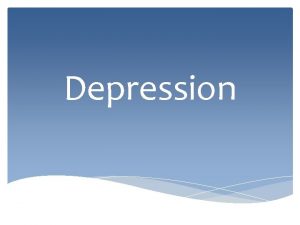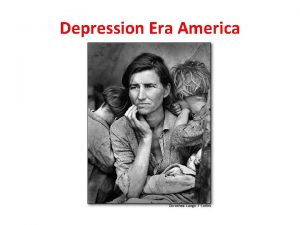Manic depression is a frustrating mess Manic Depression
















































- Slides: 48

“Manic depression is a frustrating mess” Manic Depression, Jimi Hendrix IS IT DEPRESSION OR IS IT BIPOLAR DISORDER? Jon-Paul Khoo

Depression 50 -80% of all depression management occurs in primary care One of the most common conditions in primary care � Nearly 10% of all primary care presentations are depression related Lifetime prevalence of depression is 1 in 7 (1015%) 12 month prevalence of depression is 6. 2% � Unipolar depressive episodes 4. 1% � Dysthymia 1. 3% � Bipolar disorder 1. 8% Using these figures, of depressed people, 29%

Missing bipolar disorder diagnosis 2/3 bipolar disorder patients are misdiagnosed � An average of 3. 5 times � By 4 different doctors � 1/3 are symptomatic for 10 years before diagnosis � 6 -7. 5 years between misdiagnosis and accurate diagnosis Up to about 40% of bipolar inpatients/ outpatients initially diagnosed with MDD

Bipolar disorder Under-recognised and under-diagnosed Incorrectly diagnosed as unipolar depression 31. 2% No diagnosis 49. 0% 19. 8% Correctly diagnosed with bipolar disorder Mood Disorder Questionnaire-Positive Rates (US population) n=85, 358 Hirschfeld 2003. J Clin Psychiatry 2003; 64: 53 -59.

Bipolar disorder in primary care Primary care screens � ~8 -10% bipolar disorder � 0. 5 -4. 3% bipolar disorder using structured psychiatric interviews � An example using MDQ (Das, JAMA 2005; 293: 956 -963) 9. 8% prevalence bipolar disorder on screen 49% doctor noted current evidence of depression 72. 3% had sought professional assistance 8. 4% diagnosed 6. 5% on a mood stabiliser 44% on other agents

Bipolar disorder Lifetime prevalence 1. 4 -6. 4% Chronic, recurrent and irregular course � Acute episodes are a relatively small part of the overall illness � High frequency of subsyndromal interepisode symptoms Heavy comorbidity Life impact similar to multiple sclerosis, and > endstage renal disease or rheumatoid arthritis 35% attempt suicide and lifetime risk of death by suicide up to 19% (similar to heart disease and cancer) � SMR suicide M 2. 5 F 2. 7 = SMRs for cardiovascular

DSM-5 Manic episode 1 week (or any duration if hospitalised) Abnormally and persistently � � Elevated, expansive, or irritable mood and Increased goal-directed activity or energy 3 or more of the following symptoms (4 if irritable only): � Inflated self-esteem or grandiosity � Decreased need for sleep � Increased or pressured speech � Flight of ideas/racing thoughts � Distractibility � Increased goal-directed activity or PMA � Risk-taking behaviour Severe enough to cause marked impairment, hospitalisation and/or psychotic features Exclusions

DSM-5 Hypomanic episode 4 days Abnormally and persistently � � Elevated, expansive, or irritable mood and Increased goal-directed activity or energy 3 or more of the following symptoms (4 if irritable only): � Inflated self-esteem or grandiosity � Decreased need for sleep � Increased or pressured speech � Flight of ideas/racing thoughts � Distractibility � Increased goal-directed activity or PMA � Risk-taking behaviour Change in functioning; uncharacteristic; observable: but NOT severe enough to cause marked impairment functioning or hospitalisation Exclusions

DSM-5 Bipolar and related disorders Bipolar I disorder Bipolar II disorder Cyclothymic disorder Substance/medication-induced bipolar and related disorder Bipolar and related disorder due to another medical condition Other specified and related bipolar disorders � History of MDD and subthreshold duration for hypomania � History of MDD and subthreshold number of criteria � Hypomanic episode without MDD � Short duration cyclothymia Specifiers

Other specified and related bipolar disorders Bipolar II Disorder Major Depressive Disorder Mania with psychosis Mania Hypomania Subsyndromal elevation Normal mood Subsyndromal depression Mild depression Moderate depression Severe depression with psychosis Cyclothymia Bipolar I Disorder DSM-5 Bipolar and related disorders

Akiskal’s Bipolar Spectrum

Akiskal’s Bipolar Spectrum

Causes of misdiagnosis as depression Overly restrictive DSM criteria Critical diagnostic element is elevation � � Elevation usually absent at time of diagnosis � But bipolar disorder is depression-predominant Most bipolar patients seek treatment only for depression Diagnosis often based on history rather than presentation Historical mania and hypomania are missed � Not asked after, denied or not spontaneously reported Insight impairment is common Hypomania may be subtle or constructive Feel good, creative, active, heightened well-being, energised, productive, social, invigorated � � Not considered negative or even preferred Non-classical phenomena are common Often no historical indication/record of hypomania

Frequency of symptoms Bipolar I 9. 3% disordera 5. 9% 31. 9% Bipolar II disorderb 1. 3% 2. 3% 52. 7% Time asymptomatic Time depressed 50. 3% 46. 1% Time manic / hypomanic Time cycling / mixed Irrespective of bipolar subtype, patients spend the majority of their time in the depressed state n=146, bipolar I; n=86, bipolar II Follow up: a 12. 8 years; b 13. 4 years Judd et al 2002; 2003

Onset timeline of Bipolar Disorder & ode n gs s n i i ep sw of sio s od ms of Full pres o M pto n tom 1. 3) de p f o m o i ) sy ress ym ia (2. 1 1 S 2 ( an dep 0) m. (18 15 of s tom s p s m sy illne y An ntal me. 5) (17 20 ) al t (24 c i d n Me atme tre e od s i p ll e nia u F ma f o. 3) (24 25 sis of o gn r a i D ola r bip orde dis. 0) (30 30 Age (Median) Berk 2007, Journal of Affective Disorders

Consequences of misdiagnosis as depression Inappropriate monotherapy with antidepressants � “Treatment resistant depression” which is really pseudo-resistance � May destabilise the illness Delays appropriate treatment � Increases suffering recurrence, chronicity and Worsens occupational, family, social and economic disadvantage Increased healthcare costs Increased suicide attempts

G ep AD Sc res s hi zo ion ph re ni D a ys th ym ia PT So SD ci a Pa lp ni ho c b ag d or iso ia ap rd ho er bi / de pe Al a nd co H en ho of arm ce l al fu co l ho us l e D di Bip so ol rd ar er Burden of disease across disorders averted with optimal treatment Burden of disease (YLD) [%] YLD, Years lived with disability Andrews et al 2004

Is the depression bipolar? A practical approach to mitigating bipolar misdiagnosis

Is the depression bipolar? Index of suspicion and a probabilistic approach

A probabilistic approach No pathognomonic characteristics of bipolar depression compared to major (unipolar) depressive disorder � Maintain a high index of suspicion � Consider bipolar disorder in every depressive presentation There are clinical, illness and historical characteristics more commonly associated with bipolar depression Use a probabilistic (or likelihood) approach to consider the differential likelihood of bipolar or Mitchell PB et al. Bipolar Disorders 2008; 10: 144– 152. unipolar depression

Is the depression bipolar? Index of suspicion and a probabilistic approach History � Personal history of mania/hypomania

History of mania/hypomania Duration? Abnormally and persistently � � Elevated, expansive, or irritable mood and Increased goal-directed activity or energy 3 or more of the following symptoms (4 if irritable only): � Inflated self-esteem or grandiosity � Decreased need for sleep � Increased or pressured speech � Flight of ideas/racing thoughts � Distractibility � Increased goal-directed activity or PMA � Risk-taking behaviour Severity of impairment, hospitalisation and/or psychotic features Exclusions

Is the depression bipolar? Know about bipolar disorder Index of suspicion and a probabilistic approach History � Personal history of mania/hypomania � Family history of bipolar disorder

Bipolar family history markers Consecutive generation mood disorder � Genetic anticipation Completed suicide Mood stabiliser usage Alcohol/substance use disorder Institutionalisation ? Eccentricity Clustered comorbid associations of bipolar disorder � Depression, anxiety, substance, gambling, ADHD, eating disorder

Is the depression bipolar? Know about bipolar disorder Index of suspicion and a probabilistic approach History � Personal history of mania/hypomania � Family history of bipolar disorder � Comorbidity

Comorbidity is the norm (60 -70%) � Psychiatric Anxiety disorder; personality disorder; eating disorder; ADHD; impulse control disorders � Substance use disorder � Medical disorder Migraine; MS; Cushing's syndrome; CNS neoplasm; head trauma; asthma; obesity; T 2 DM; CVD; metabolic syndrome; thyroid disorder Clustering raises suspicion May alter presentation May dominate presentation May influence physician diagnostic response

Is the depression bipolar? Know about bipolar disorder Index of suspicion and a probabilistic approach History � Personal history of mania/hypomania � Family history of bipolar disorder � Comorbidity � Look for bipolar markers in illness course

Markers for bipolarity in illness course Onset Postpartum � Early age (<25 years) � More equal gender ratio � Past illness history High number of prior depressive episodes � Frank elevation (nb mixed presentations) � Sudden onset/offset (“abruptness” and shorter episodes) � Seasonal mood variations (winter depressions) � History of recurrent but brief depressive episodes � Treatment history Response to mood-stabilisers � Adverse reactions to antidepressants �

Is the depression bipolar? Know about bipolar disorder Index of suspicion and a probabilistic approach History � Personal history of mania/hypomania � Family history of bipolar disorder � Comorbidity � Look for bipolar markers in illness course � Adverse reactions to antidepressants

Adverse reactions to antidepressants Antidepressant-induced mood disturbances � Gross activation � Elevation (mania/hypomania) � Induction of mixed states � Cycle destabilisation/acceleration (rapid-cycling) Atypical reactions � Antidepressant inefficacy � Antidepressant “tolerance”/“Poop-out” � On-off phenomena

Is the depression bipolar? Know about bipolar disorder Index of suspicion and a probabilistic approach History � Personal history of mania/hypomania � Family history of bipolar disorder � Comorbidity � Look for bipolar markers in illness course � Adverse reactions to antidepressants Look for bipolar markers on examination

Phenomenological markers for bipolarity on mental state examination: Atypical features � Hypersomnia, leaden paralysis, hyperphagia and weight gain Irritability and other mixed features � DSM-5 MDE with mixed features Greater suicidality Catatonia and/or psychotic features (pathological guilt) Lability of mood Flatness/emotionlessness rather than sadness/crying More melancholic features � Psychomotor retardation, severe anhedonia, EMW and DMV Greater probability of substance abuse More anxiety Anger attacks Fewer physical complaints

A probabilistic approach Mitchell PB et al. Bipolar Disorders 2008: 10: 144– 152.

Is the depression bipolar? Know about bipolar disorder Index of suspicion and a probabilistic approach History � Personal history of mania/hypomania � Family history of bipolar disorder � Comorbidity � Look for bipolar markers in illness course � Adverse reactions to antidepressants Look for bipolar markers on examination Use bipolar symptom screening instrument

Bipolar symptom screening instruments Mood Disorder Questionnaire

Ø Ø Ø ≥ 7/13 items Concurrence ≥ Moderate impact Family history Previous diagnosis

Bipolar symptom screening instruments Mood Disorder Questionnaire Black Dog Institute � Bipolar Self-test (Mood Swings Questionnaire)

Black Dog Bipolar Self-test part 1

Black Dog Bipolar Self-test part 2

Bipolar symptom screening instruments Mood Disorder Questionnaire Black Dog Institute � Bipolar Self-test (Mood Swings Questionnaire) � Mood Assessment Program (MAP)


Bipolar symptom screening instruments Mood Disorder Questionnaire Black Dog Institute � Bipolar Self-test (Mood Swings Questionnaire) � Mood Assessment Program (MAP) Hypomania Checklist (HCL 32)

Bipolar symptom screening instruments Mood Disorder Questionnaire Black Dog Institute � Bipolar Self-test (Mood Swings Questionnaire) � Mood Assessment Program (MAP) Hypomania Checklist (HCL 32) The Bipolarity Index

Bipolarity Index

Is the depression bipolar? Know about bipolar disorder Index of suspicion and a probabilistic approach History � Personal history of mania/hypomania � Family history of bipolar disorder � Comorbidity � Look for bipolar markers in illness course � Adverse reactions to antidepressants Look for bipolar markers on examination Use bipolar symptom screening instrument Involve significant other(s) in assessment

Is the depression bipolar? Know about bipolar disorder Index of suspicion and a probabilistic approach History � Personal history of mania/hypomania � Family history of bipolar disorder � Comorbid associations � Look for bipolar markers in illness course � Adverse reactions to antidepressants Look for bipolar markers on examination Use bipolar symptom screening instrument Involve significant other(s) in assessment Refer for specialist consultation

Summary and conclusions Depressive presentations are common Not all depression is MDD Bipolar disorder is a more severe disorder that requires different and more complicated treatments Bipolar disorder is commonly misdiagnosed as MDD for reasons relating to nosological, illness, patient and physician factors Correctly diagnosing bipolar disorder ensures appropriate treatment and reduces patient adversity

Summary and conclusions You can mitigate bipolar disorder misdiagnosis in your practice tomorrow by � Understanding, suspicion and a probabilistic approach � Asking after previous elevation, family history and comorbidity � Looking for bipolar markers in illness course, treatment history and mental state psychopathology � Using a bipolar symptom screening instrument � Involving significant others in assessment
 Melcor manic
Melcor manic Manic monday definition
Manic monday definition What does frustrating mean
What does frustrating mean Classification of riddles
Classification of riddles Parents mess you up poem
Parents mess you up poem Huntley community association
Huntley community association Disadvantages of piezoelectric accelerometer
Disadvantages of piezoelectric accelerometer Till rhyming words
Till rhyming words Does fertility blend work
Does fertility blend work Songkok istiadat tentera darat
Songkok istiadat tentera darat Lal bahadur shastri national academy of administration
Lal bahadur shastri national academy of administration A beautiful mess gomi
A beautiful mess gomi Fuck mum
Fuck mum The whole paper
The whole paper Anxiety in the heart of man causes depression
Anxiety in the heart of man causes depression Chapter 20 from business culture to great depression
Chapter 20 from business culture to great depression Sec the great depression
Sec the great depression Successive period
Successive period When was thegreat depression
When was thegreat depression Nice guidelines postnatal depression
Nice guidelines postnatal depression Great depression jeopardy
Great depression jeopardy Laissez faire great depression
Laissez faire great depression Using a doppler ultrasound device gmat
Using a doppler ultrasound device gmat Trough in business cycle
Trough in business cycle Effects of hospitalization on the family of the child
Effects of hospitalization on the family of the child Hardship and suffering during the depression
Hardship and suffering during the depression Relief rain
Relief rain How did the great depression affect south carolina
How did the great depression affect south carolina Finding angle of depression
Finding angle of depression Hardship and suffering during the depression
Hardship and suffering during the depression Great depression webquest
Great depression webquest The great depression leq
The great depression leq Great depression vocab
Great depression vocab 5 phasen der depression
5 phasen der depression Http://www.history.com/topics/great-depression
Http://www.history.com/topics/great-depression 8-4 angles of elevation and depression
8-4 angles of elevation and depression Great depression photographer
Great depression photographer 8-4 angles of elevation and depression
8-4 angles of elevation and depression Becks depression inventory
Becks depression inventory How did the great depression impact the world
How did the great depression impact the world Freezing point depression examples in real life
Freezing point depression examples in real life Main idea
Main idea Describe the human toll of the great depression
Describe the human toll of the great depression Operational definition example
Operational definition example Great depression
Great depression Nevaton forte for depression
Nevaton forte for depression Great depression causes
Great depression causes Major terrain features
Major terrain features Depression counseling humble
Depression counseling humble
